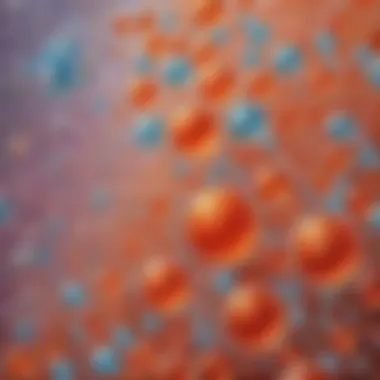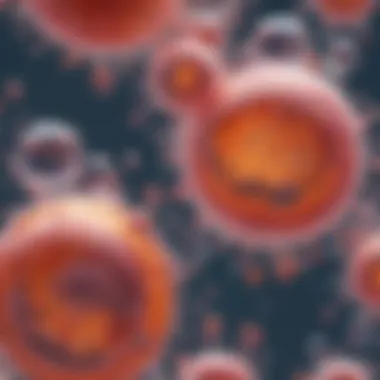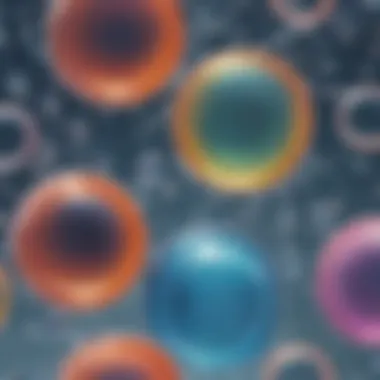Unveiling the Intriguing Science Behind Bubbles in Soda


Science Fun Facts
Soda bubbles, those tiny little balls of gas in your favorite carbonated drinks. Have you ever wondered how they form and why they tickle your nose? Well, hold on tight as we plunge into the intriguing world of bubbles in soda.
Ever noticed that satisfying fizz sound when you crack open a can of soda? That's the carbon dioxide molecules eagerly escaping from their liquid prison. Once freed, these molecules rush to the surface, forming bubbles that dance merrily in your drink.
Contrary to popular belief, it's not just about the taste. Bubbles play a crucial role in enhancing the sensory experience of soda. The more bubbles, the bubblier the drink, creating that delightfully effervescent sensation on your tongue.
Discover the Wonders of Science
Wondering how bubbles actually form in your soda? It's all about a process called nucleation. This fancy term simply refers to the formation of tiny bubbles at specific points in the liquid. In the case of soda, these points are often imperfections on the container's surface or tiny particles suspended in the liquid.
Have you ever tried shaking a bottle of soda vigorously and then opening it? The explosive release of gas and bubbles is due to the agitation causing the carbon dioxide to form bubbles rapidly. This sudden burst of effervescence is what creates that fizzing sensation we all know and love.
Curious about why some sodas are fizzier than others? It all comes down to the amount of dissolved carbon dioxide in the drink. The higher the pressure inside the bottle or can, the more gas can be dissolved in the liquid, resulting in a fizzier soda.
Science Quiz Time
Let's test your knowledge with a fun quiz about bubbles in soda!
- What is the scientific term for the formation of bubbles in a liquid? A) Carbonation B) Nucleation C) Effervescence
- What role do bubbles play in soda? A) Adding color B) Enhancing taste C) Cooling the drink
- Why does shaking a bottle of soda before opening it cause an effervescent reaction? A) Increases carbon dioxide content B) Forms bubbles rapidly C) Changes the flavor
Science Experiment Showcase
Ready to conduct a simple yet fascinating experiment on bubbles in soda? Here's what you'll need:
Materials: A clear glass, a variety of sodas, a stopwatch, a pen, and paper.
- Pour different sodas into the glass one at a time and observe the bubble formation. Take notes on which soda produces the most bubbles and represents the best fizz.
- Use the stopwatch to time how long the bubbles last in each type of soda. Record your findings and see if there's a correlation between bubble longevity and soda brand.
- Discuss your results and hypotheses with friends or family members to unravel the mystery behind bubbles in soda!


Remember to handle sodas carefully, as they can be sticky and slippery. Enjoy your bubbly experiment and the wonders of science!
Introduction
When you open a can of soda and those tiny bubbles dance to the surface, have you ever wondered about the science behind this effervescent phenomenon? This article delves into the captivating world of bubbles in soda, unraveling the intricate chemical and physical processes that govern their formation. From understanding the molecular composition to exploring real-world applications, we embark on a journey to unveil the in-depth science behind this everyday occurrence.
Understanding the Basics
In order to grasp the essence of soda bubbles, it is essential to first comprehend the fundamental elements at play. Let's break down the building blocks of a fizzy drink – soda.
The Composition of Soda
At the heart of every soda lies its unique composition, blending ingredients like carbonated water, sweeteners, acids, flavors, and often, caffeine. The carbonated water acts as the canvas upon which the magic of bubbles unfolds. Its effervescence adds a distinct liveliness to the beverage, making it a popular choice for consumers seeking a refreshing experience. However, the reliance on artificial sweeteners and acids poses certain health concerns, underscoring the need for moderation in consumption.
The Role of Carbonation
Carbonation plays a pivotal role in the soda-making process. By infusing carbon dioxide under pressure into the liquid, the iconic fizziness that characterizes sodas is achieved. This process not only enhances the drink's sensory appeal but also contributes to its longevity on the market. Yet, the excessive intake of carbonation may lead to potential digestive issues, underscoring the importance of consuming such beverages in moderation.
Introduction to Bubbles
As carbonation meets liquid, bubbles emerge – a visual spectacle that captivates soda enthusiasts worldwide. These bubbles serve not only as a testament to the carbonation process but also enhance the overall drinking experience. However, excessive bubble formation can sometimes lead to a rapid loss of carbonation, impacting the beverage's quality.
Importance of Studying Bubbles
Delving deeper into the realm of bubbles in soda, it becomes apparent why studying this natural occurrence holds significant value across various disciplines.
Applications in Food Science
From enhancing texture to modulating flavor profiles, bubbles play a vital role in the realm of food science. In the context of soda production, bubbles contribute not only to mouthfeel but also influence how flavors are perceived. Understanding the dynamics of bubbles can thus pave the way for innovations in food and beverage industries, driving sensory experiences to new heights.
Impact on Beverage Quality


The presence of bubbles in sodas is a key indicator of freshness and quality. Bubbles not only tickle the taste buds but also act as a visual cue for consumers, signaling the beverage's carbonation level. However, alterations in bubble size or distribution can adversely affect the overall drinking experience, underscoring the importance of maintaining optimal bubble dynamics.
Relevance in Physics
Beyond its culinary implications, the study of bubbles in soda holds relevance in the realm of physics. By examining the interactions between gas, liquid, and container surfaces, physicists can glean insights into broader phenomena like pressure differentials and diffusion mechanisms. The implications extend beyond the confines of a soda can, offering a window into the fundamental principles that govern our physical world.
Chemical Processes
Chemical Processes hold a crucial role in unraveling the enigma behind bubbles in soda. By understanding the chemical reactions occurring within a carbonated beverage, we gain insight into the formation and behavior of bubbles. The composition of soda, primarily consisting of water, sweeteners, flavorings, and carbon dioxide, catalyzes a fascinating interplay of elements that result in effervescence. Delving into these interactions provides a foundational understanding of how bubbles come to life in your favorite fizzy drink.
Carbon Dioxide Dissolution
Solubility Factors
In the realm of carbon dioxide dissolution, solubility factors emerge as key determinants shaping the fizzy nature of soda. Solubility, the ability of a substance to dissolve in a solvent, plays a pivotal role in determining the carbonation levels of a beverage. Factors such as pressure and temperature intricately influence the solubility of carbon dioxide in water. This dynamic relationship not only impacts the effervescence of soda but also contributes to its taste and mouthfeel. Understanding the nuances of solubility factors allows us to appreciate the delicate balance required to achieve the perfect bubble-rich soda.
Impact of Temperature
Temperature acts as a potent influencer in the dissolution of carbon dioxide, exerting a significant impact on bubble formation. As temperature rises, the solubility of gases in liquids decreases, leading to the liberation of carbon dioxide bubbles. This phenomenon explains why soda tends to release more bubbles when heated or left in a warm environment. By recognizing the effect of temperature on carbon dioxide solubility, one can manipulate the fizziness of soda to cater to personal preferences, adding a nuanced layer to the intricate world of bubbles in carbonated drinks.
Nucleation Sites
Role of Imperfections
Imperfections within the soda itself or on the surface of a glass act as crucial nucleation sites, kickstarting the formation of bubbles. These imperfections provide the necessary rough surfaces for dissolved carbon dioxide to rapidly gather and form bubbles. The presence of impurities or irregularities in the container or the soda instigates the nucleation process, amplifying the effervescent experience. Understanding the role of imperfections sheds light on why bubbles appear to spontaneously form and ascend within a freshly poured glass of soda.
Container Influence
The type of container holding a carbonated beverage significantly influences the formation and retention of bubbles. Smooth surfaces minimize nucleation sites, leading to fewer bubbles in the drink, whereas rough or scratched surfaces promote bubble formation. Additionally, the shape and material of the container also impact how bubbles evolve and interact within the liquid. Recognizing the influence of the container on bubble dynamics provides a novel perspective on the science behind the effervescence we commonly encounter in soda.
Physical Phenomena


Physical Phenomena in the context of this article explores the intricate processes governing bubble formation in soda, shedding light on the underlying mechanisms that define the behavior of bubbles in this carbonated beverage. By delving into the realm of Physical Phenomena, we gain a deeper understanding of the specific elements at play, such as bubble growth, collapse, and the dynamics of gas diffusion within the liquid matrix. This section serves as a cornerstone in unraveling the mysteries of soda bubbles, offering insights into their formation and stability. Understanding Physical Phenomena is crucial in deciphering the nuances that contribute to the effervescence and sensory experience of carbonated drinks.
Bubble Growth and Collapse
Within the realm of bubble dynamics, the phenomenon of Gas Diffusion Mechanisms plays a pivotal role in the overall formation and evolution of bubbles in soda. Gas diffusion refers to the movement of gas molecules from regions of higher concentration to lower concentration within the soda solution. This process contributes significantly to the growth of bubbles, creating the characteristic effervescence observed in carbonated beverages. The key characteristic of Gas Diffusion Mechanisms lies in its ability to drive the expansion of bubbles, leading to their eventual rise to the surface. This mechanism is crucial in maintaining the effervescent nature of sodas, ensuring a lively and appealing drinking experience. While gas diffusion is an efficient method for bubble growth, it can also result in rapid bubble formation under specific conditions, which may influence the overall drink quality.
Pressure Variations, another integral aspect of bubble dynamics, further refines the formation and stability of bubbles in soda. Pressure differentials within the liquid medium impact the growth, movement, and eventual collapse of bubbles. The key characteristic of Pressure Variations lies in its ability to regulate bubble size and distribution throughout the liquid, influencing the sensory aspects of carbonation. By understanding and manipulating pressure variations, beverage manufacturers can tailor the effervescence levels of sodas to meet consumer preferences. Balancing pressure differentials is essential in maintaining optimal bubble dynamics, ensuring a consistent and enjoyable carbonated beverage experience for consumers.
Surface Tension Effects
Exploring the effects of surface tension on bubble shape provides valuable insights into the stability and longevity of bubbles in soda. Surface tension, a fundamental property of liquids, dictates the shape and behavior of bubbles as they form and rise through the liquid matrix. The impact of surface tension on bubble shape highlights its pivotal role in determining the structural integrity of bubbles, influencing their ability to resist external forces and maintain their form. Understanding this aspect is essential in optimizing bubble stability and longevity in carbonated beverages.
The relationship between bubble size and surface tension further deepens our understanding of bubble dynamics in soda. As bubble size varies, surface tension exerts differential effects on the structural integrity and lifespan of bubbles. By elucidating this relationship, researchers and beverage experts can fine-tune the carbonation process to achieve the desired bubble characteristics in sodas. Balancing bubble size with surface tension properties is critical in crafting beverages that offer consistent effervescence and sensory appeal to consumers.
Real-World Applications
In this expansive journey through the realm of soda bubbles, the section of Real-World Applications stands as a pinnacle of practical knowledge. It bridges the gap between theoretical concepts and tangible outcomes, offering invaluable insights into how the scientific intricacies discussed earlier manifest in everyday scenarios. By exploring carbonation techniques used in both industrial beverage production and home carbonation devices, we can witness firsthand how the principles of bubble dynamics shape the beverages we enjoy. This section serves as a bridge between theory and practice, illuminating the relevance of understanding bubble science beyond the laboratory.
Carbonation Techniques
Industrial Beverage Production
As we delve into the depths of industrial beverage production, the significance of precise carbonation techniques becomes evident. The art of infusing the right amount of carbon dioxide into beverages requires a delicate balance of science and craftsmanship. This meticulous process not only impacts the effervescence of sodas but also plays a crucial role in determining mouthfeel and taste. The controlled environment of industrial production ensures consistency in carbonation levels, leading to enhanced product quality and consumer satisfaction. Despite the mechanization involved, human expertise remains paramount in fine-tuning carbonation to perfection. The synergy between technology and tradition in industrial beverage production highlights the artistry behind creating the bubbly delights we savor.
Home Carbonation Devices
Contrasting the industrial scale, home carbonation devices offer a glimpse into the personalized side of bubble dynamics. Empowering individuals to craft their fizzy concoctions, these devices bring experimentation and customization to the forefront. The key characteristic of home carbonation devices lies in their user-friendly nature, enabling enthusiasts to explore the science of carbonation in the comfort of their kitchens. While industrial production focuses on mass appeal, home devices cater to niche preferences, allowing for creative flavor combinations and carbonation levels. The unique feature of these devices lies in their accessibility and agility, offering a hands-on approach to understanding the nuances of bubble formation. While limitations exist in terms of volume and pressure compared to industrial setups, the charm of experimentation and customization makes home carbonation devices a popular choice among soda aficionados.
Bubble Dynamics in Drinks
Fizz Retention Strategies
Among the array of bubble dynamics, fizz retention strategies emerge as a critical component in beverage preservation. The ability to prolong carbonation levels in drinks not only enhances sensory experience but also influences consumer perception of freshness. Leveraging various techniques such as ingredient selection and bottling processes, fizz retention strategies aim to captivate taste buds and uphold product integrity. The key characteristic of these strategies lies in their dual role of preserving carbonation while preserving flavor profiles, striking a delicate balance between effervescence and taste. While advantageous in maintaining product appeal, challenges such as ingredient interaction and storage conditions demand meticulous attention in the implementation of fizz retention strategies.
Enhanced Flavor Delivery
In the realm of enhanced flavor delivery, the interplay between bubble dynamics and taste sensations takes center stage. By harnessing the influence of carbonation on flavor release, beverage makers can amplify taste experiences and cater to evolving consumer palates. The key characteristic of enhanced flavor delivery lies in its ability to intensify taste perception through controlled carbonation levels, creating a symphony of flavors with each sip. This approach not only enhances the sensory enjoyment of beverages but also showcases the intricate relationship between bubbles and taste. Despite its benefits in elevating drinking experiences, the careful calibration required to achieve desired flavor profiles underscores the complexity of leveraging bubble dynamics for enhanced flavor delivery.







